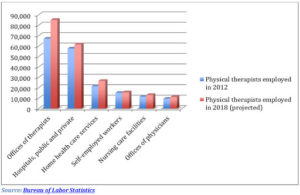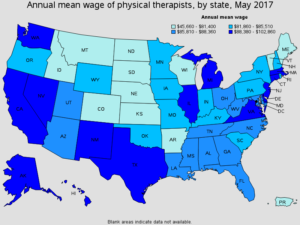Hawaii has limited economic sectors heavily depending on Government entities, Federal, Military and primarily State, and then tourist industries. That was the reason why government worked on creating incentives for other industries to come to Hawaii, however the effect has been minimal. Some of the industries that Stat of Hawaii tried to bring to Hawaii by providing tax incentive is technology, bio-medical, and movie industries. As Hawaii population ages medical industry is about to hit a tipping point as doctor shortages are right around the corner and supporting medical industry is becoming shorthanded. Today we’ll explore one small segment of that issue. Especially since Hawaii doesn’t have a Physical Therapy school, as the demand for the service grows it is becoming a bigger problem for our islands. In order to highlight the issue and with hope to bring more physical therapists to Hawaii, by the way being a physical therapist in Hawaii is a pretty good gig, we wanted to take a quick break from tech side of things and share some info on medical field.
Becoming a physical therapist has benefits and drawbacks, but the advantages far outweigh the difficulties. The benefits include a high salary, excellent professional working conditions, respect from patients, their families, and the general public and strong job satisfaction. Physical therapists can work in a variety of clinical and management jobs in locations throughout the world. The cons include an extended educational requirement, demanding physical work, high costs of financing an education, and the necessity of dealing with people who aren’t always on their best behavior.
Qualifying for a Job as a Physical Therapist
In the United States, people must receive a bachelor’s degree in a related field of study and a graduate degree in physical therapy from an accredited institute of higher learning. Unfortunately, there is no master’s degree program for physical therapy, so candidates must earn a Ph.D. to qualify. Candidates must also pass a standardized national exam to get a license.
It’s important to have a good understanding of what the job of physical therapy entails before committing to a course of study. Common duties of physical therapists include:
· Examining patients and conducting tests, x-rays, MRIs, etc.
· Making a diagnosis of the problems
· Formulating a plan to treat debilitations and relieve pain
· Following up to ensure that the plan is workable and followed by the patient
· Helping patients perform therapy
· Performing skilled treatments, such as massage, traction, and other therapies
· Dealing with families who are often in crisis situations
Outlook for Becoming a Physical Therapist
 According to the Bureau of Labor Statistics, physical therapy jobs will increase by 71,800 jobs by 2024. That stat demonstrates that these jobs are in high demand. Physical therapy jobs become increasingly important as baby boomers age to become the largest retirement-age-or-older population in history. Physical therapy treats not only accidents but also disabilities caused by aging.
According to the Bureau of Labor Statistics, physical therapy jobs will increase by 71,800 jobs by 2024. That stat demonstrates that these jobs are in high demand. Physical therapy jobs become increasingly important as baby boomers age to become the largest retirement-age-or-older population in history. Physical therapy treats not only accidents but also disabilities caused by aging.
Those who want to get a jumpstart on a career in physical therapy should pursue computer science, biology, and anatomy courses in high school and college. Other valuable courses include patient psychology, kinesiology, healthcare administration, and general science, and advanced mathematics courses.
Once a candidate gets hired as a physical therapist, he or she might work in a variety of jobs, such as helping patients cope with emotional problems, dealing with spinal trauma, performing hands-on therapy, leading patients in exercise and stretching routines, and managing pain as patients recuperate.
The work environment is excellent because most physical therapists work with physicians, surgeons, and physical therapist assistants in clinics, hospitals, private practices, nursing homes, and educational institutions. The work is typically done during normal business hours, but private practices often schedule evening and weekend hours.
Salary Considerations for Becoming a Physical Therapist
The salaries of physical therapists rank among the highest salaries for entry-level employees, and there are many more lucrative positions for those who advance into private practice and administration. Physical therapists earned $86,850 in 2017, and the highest-paid therapists earned an average of $101,790. Both salary levels and the number of jobs has increased steadily in the physical therapy field since 2010, and the BLS predicts the field will grow by 28 percent between 2016 and 2026, a much higher rate than most other careers, including medical jobs.
 The pay average for physical therapists varies among geographic regions and cities throughout the United States. The top salaries in the country are paid to therapists in the following cities:
The pay average for physical therapists varies among geographic regions and cities throughout the United States. The top salaries in the country are paid to therapists in the following cities:
· Merced, California: $128,040
· Hammond, Louisiana: $123,430
· Morristown, Tennessee: $117,110
You can find one example for Hawaii physical therapist here.
Physical Therapists Assume Multiple Duties
As the medical profession continues to specialize, physical therapists perform essential rehab work and provide emotional support that general practitioners seldom offer patients in today’s specialized medicine. People with injuries, chronic conditions, asthma, spinal problems, and difficulties recovering from various illnesses can benefit from a proactive regimen of physical therapy, so the outlook for becoming a physical therapist is overwhelmingly positive.
And as we pointed out in the beginning of the article, the prospect for career in physical therapy in Hawaii is even better. Come join us and enjoy the beautiful weather together.
References:
[1] https://www.topoccupationaltherapyschool.com/pros-and-cons-of-being-a-physical-therapist/
[2] https://www.masmedicalstaffing.com/2018/02/20/pros-and-cons-of-being-a-physical-therapist/
[3] https://money.usnews.com/careers/best-jobs/physical-therapist/salary
